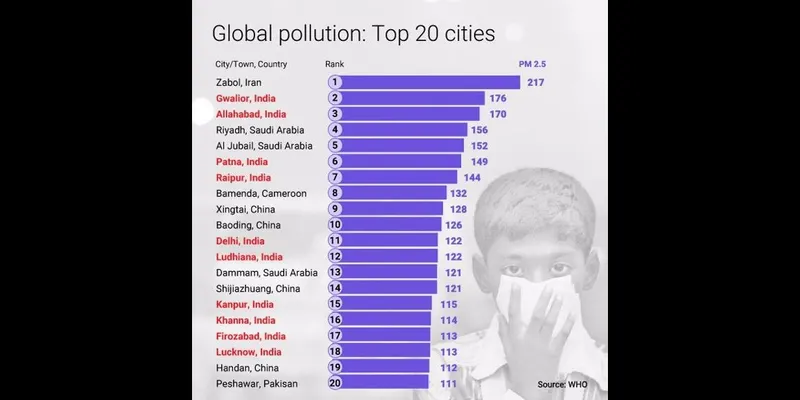

Clean Energy Revolution: India
A CLEAN STEP TOWARDS A GREEN FUTURE AND WHATS IN IT FOR BUSINESSES
With India taking the lead role in the formation of The International Solar Alliance we are now curious to exploit the power of our beloved star. The initiative was launched at the UN Climate Change Conference in Paris on 30 November 2015 by Indian Prime Minister Narendra Modi and French President Francois Hollande. It was joined by 121 countries. We are on our way to achieve the goal of producing 100 GW of energy through solar power by 2022.

But WHY do we need Clean Energy in India?
According to WHO reports for 2014 of top 20 most polluted cities of the world, shockingly there are 10 Indian cities. Gwalior being the 2nd on the list and surprisingly our capital is behind Gwalior, Allahabad and other Indian cities, landing a position at number 11. For a country aiming at becoming a developed superpower, this is a wake up call.

Global Pollution : Top 20 Cities as of 2014
So what are we doing about it?
The potential energy from sunlight which shines throughout the year in India (and in all the countries lying the tropic of cancer or tropic of Capricorn or near these countries to say) should be harnessed and used to share the burden of providing energy with non-renewable resources through simple devices such as solar panels and solar appliances that already exist and need to be scaled up and made accessible. This can dramatically improve the quality of life in rural and semi-urban areas that are currently in darkness due to lack of electricity grid. Through ISA (International Solar Alliance), partnerships are provided to countries facing similar problems, where farmers do not have access to technology to improve their production or where there are problems of clean drinking and other energy requirement.

What is in it for Startups and Businesses focusing on Renewable Energy?
Promote solar technologies and investment in the solar sector to enhance income generation.
Formulate projects and programmes that promote solar applications. This is to be done on governmental as well as private basis. The more Applications that use solar energy or renewable energy, the less the burden on conventional energy resources.
Develop innovative Financial Mechanisms to reduce cost of capital. Lesser the capital cost, the more the investors will be attracted in a potentially successful Business and more benefits for the customers.This is to help the upcoming companies that are harnessing solar energy.
Facilitate capacity building for promotion and absorption of solar technologies and R&D in Developing Countries. It is only through R&D that we can come up with more efficient mechanisms and cheaper technologies for Non-renewable energy application. As of the present scenario, we use only a little part of renewable energy which we have access. There is a much greater potential for what we can do. Lets have a look at few interesting statistics:

A “quad Btu” refers to one quadrillion British Thermal Units of energy, a common term used by energy economists.
The entire human race currently uses about 400 quads of energy (in all forms) per year. The solar energy hitting the earth exceeds the total energy consumed by humanity by a factor of over 20,000 times.
The more renewable energy that we use the less burden on conventional sources of energy, but it’s not only the conventional sources of energy that we are concerned about, it’s also about the ill effects we are causing to the nature , our health and depleting the biodiversity of the planet.
Hybrid Energy Storage Systems (HESS) for Renewable Resources
While we are fully capable of producing energy from renewable resources, we are also mastering the technology of storing the renewable energy. An HESS is characterized by a beneficial coupling of two or more energy storage technologies with supplementary operating characteristics (such as energy and power density, self-discharge rate, efficiency, life-time, etc.). With the world constantly suffering the increasing ill effects of rising CO2 and other green houses in the environment, it has now become very important to shift our focus on moving from fossil fuels to renewable energies like PV (photo voltaic cell), Wind Energy, Hydro Kinetic Energy etc and we need this transition fast. A number of storage technologies based on electrical, mechanical, chemical and thermal energy storage principles are available with quite different technical parameters and operating characteristics. Current system analysis studies indicate energy storage demand on a short-, mid- and long-term time scale. At this point, the utilization of the hybrid energy storage system (HESS) approach, integrating storage technologies with supplementary operating characteristics, can be very beneficial.
The Powerwall initiative: It is a new open source Technology from Tesla that converts and stores the energy from solar panels, this energy can be used later at night or during a power outage. Though still under development and production stage, this could be a potential game changer for the future. It will allow the users to stay completely independent from the electric power grid and give permanent security from power outages. It application also include power backup services.
Important Links:







